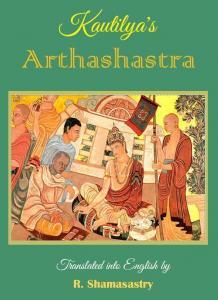
The Arthashastra was written by Kautilya who was both teacher and guardian of the Indian Emperor Chandragupta Maurya (321–297 BCE). Chandragupta Maurya established one of the greatest kingdoms of India, the Maurya Empire.
The Arthashastra was widespread until the 12th century when it disappeared. It was rediscovered in 1905 by R. Shamasastry, who published it in 1909 and later translated the text to English. The book is basically a treatise on the art of government. It lays down the rules of policy for the complete tyrant, describing the
organization of his palace, his court, and his state in such fashion as to make Machiavelli seem a liberal. The first rule is that he must trust no one, and be without a single intimate friend. Beyond this, he must organize his government as a series of concentric circles composed of the various ministers, generals, officers, secretaries, and servants who execute his orders, every circle constituting a degree of rank leading up to the king himself at the center like a spider in its web.
The book furthermore deals with government, society, politics, warfare, and ethics as well as esoteric practices, justice, and how to deal with weak rulers. Here is a chapter from the more than 600 pages book about the personal safety of the king, with special empathize on how to avoid food poisoning:
ON getting up from the bed, the king shall be received by troops of women armed with bows. In the second compartment, he shall be received by the Kanchuki (presenter of the king’s coat), the Ushnisi (presenter of king’s head-dress), aged persons, and other harem attendants. In the third compartment, he shall be received by crooked and dwarfish persons; in the fourth, by prime ministers, kinsmen, and doorkeepers with barbed missiles in their hand. The king shall employ as his personal attendants those whose fathers and grandfathers had been royal servants, those who bear close relationship to the king, those who are well trained and loyal, and those who have rendered good service. Neither foreigners, nor those who have earned neither rewards nor honour by rendering good service, nor even natives found engaged in inimical works shall form the bodyguard of the king or the troops of the officers in charge of the harem. In a well-guarded locality, the head-cook (máhánasika) shall supervise the preparation of varieties of relishing dishes. The king shall partake of such fresh dishes after making an oblation out of them first to the fire and then to birds.
When the flame and the smoke turn blue and crackle, and when birds (that eat the oblation) die, presence of poison (in the dish) shall be inferred. When the vapour arising from cooked rice possesses the colour of the neck of a peacock, and appears chill as if suddenly cooled, when vegetables possess an unnatural colour, and are watery and hardened, and appear to have suddenly turned dry, being possessed of broken layers of blackish foam, and being devoid of smell, touch and taste natural to them; when utensils reflect light either more or less than usual, and are covered with a layer of foam at their edges; when any liquid preparation possesses streaks on its surface; when milk bears a bluish streak in the centre of its surface; when liquor and water possess reddish streaks; when curd is marked with black and dark streaks, and honey with white streaks; when watery things appear parched as if overcooked and look blue and swollen; when dry things have shrinked and changed in their colour; when hard things appear soft, and soft things hard; when minute animalculæ die in the vicinity of the dishes; when carpets and curtains possess blackish circular spots, with their threads and hair fallen off; when metallic vessels set with gems appear tarnished as though by roasting, and have lost their polish, colour, shine, and softness of touch, presence of poison shall be inferred.
Download the free PDF version of The Arthashastra here:


Be